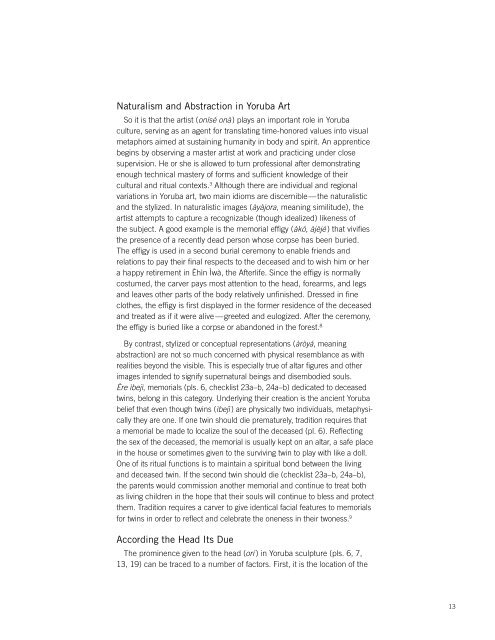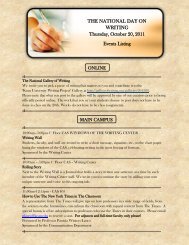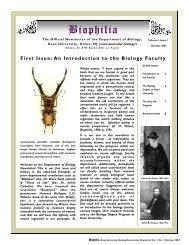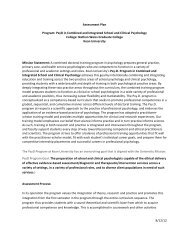Embodying the Sacred in Yoruba Art - Kean University
Embodying the Sacred in Yoruba Art - Kean University
Embodying the Sacred in Yoruba Art - Kean University
Create successful ePaper yourself
Turn your PDF publications into a flip-book with our unique Google optimized e-Paper software.
Naturalism and Abstraction <strong>in</strong> <strong>Yoruba</strong> <strong>Art</strong><br />
So it is that <strong>the</strong> artist (onísé onà) plays an important role <strong>in</strong> <strong>Yoruba</strong><br />
culture, serv<strong>in</strong>g as an agent for translat<strong>in</strong>g time-honored values <strong>in</strong>to visual<br />
metaphors aimed at susta<strong>in</strong><strong>in</strong>g humanity <strong>in</strong> body and spirit. An apprentice<br />
beg<strong>in</strong>s by observ<strong>in</strong>g a master artist at work and practic<strong>in</strong>g under close<br />
supervision. He or she is allowed to turn professional after demonstrat<strong>in</strong>g<br />
enough technical mastery of forms and sufficient knowledge of <strong>the</strong>ir<br />
cultural and ritual contexts. 3 Although <strong>the</strong>re are <strong>in</strong>dividual and regional<br />
variations <strong>in</strong> <strong>Yoruba</strong> art, two ma<strong>in</strong> idioms are discernible—<strong>the</strong> naturalistic<br />
and <strong>the</strong> stylized. In naturalistic images (àyàjora, mean<strong>in</strong>g similitude), <strong>the</strong><br />
artist attempts to capture a recognizable (though idealized) likeness of<br />
<strong>the</strong> subject. A good example is <strong>the</strong> memorial effigy (àkó, àjèjé ) that vivifies<br />
<strong>the</strong> presence of a recently dead person whose corpse has been buried.<br />
The effigy is used <strong>in</strong> a second burial ceremony to enable friends and<br />
relations to pay <strong>the</strong>ir f<strong>in</strong>al respects to <strong>the</strong> deceased and to wish him or her<br />
a happy retirement <strong>in</strong> Èhìn Ìwà, <strong>the</strong> Afterlife. S<strong>in</strong>ce <strong>the</strong> effigy is normally<br />
costumed, <strong>the</strong> carver pays most attention to <strong>the</strong> head, forearms, and legs<br />
and leaves o<strong>the</strong>r parts of <strong>the</strong> body relatively unf<strong>in</strong>ished. Dressed <strong>in</strong> f<strong>in</strong>e<br />
clo<strong>the</strong>s, <strong>the</strong> effigy is first displayed <strong>in</strong> <strong>the</strong> former residence of <strong>the</strong> deceased<br />
and treated as if it were alive—greeted and eulogized. After <strong>the</strong> ceremony,<br />
<strong>the</strong> effigy is buried like a corpse or abandoned <strong>in</strong> <strong>the</strong> forest. 8<br />
By contrast, stylized or conceptual representations (àròyá, mean<strong>in</strong>g<br />
abstraction) are not so much concerned with physical resemblance as with<br />
realities beyond <strong>the</strong> visible. This is especially true of altar figures and o<strong>the</strong>r<br />
images <strong>in</strong>tended to signify supernatural be<strong>in</strong>gs and disembodied souls.<br />
Ère ìbejì, memorials (pls. 6, checklist 23a–b, 24a–b) dedicated to deceased<br />
tw<strong>in</strong>s, belong <strong>in</strong> this category. Underly<strong>in</strong>g <strong>the</strong>ir creation is <strong>the</strong> ancient <strong>Yoruba</strong><br />
belief that even though tw<strong>in</strong>s (ìbejì ) are physically two <strong>in</strong>dividuals, metaphysically<br />
<strong>the</strong>y are one. If one tw<strong>in</strong> should die prematurely, tradition requires that<br />
a memorial be made to localize <strong>the</strong> soul of <strong>the</strong> deceased (pl. 6). Reflect<strong>in</strong>g<br />
<strong>the</strong> sex of <strong>the</strong> deceased, <strong>the</strong> memorial is usually kept on an altar, a safe place<br />
<strong>in</strong> <strong>the</strong> house or sometimes given to <strong>the</strong> surviv<strong>in</strong>g tw<strong>in</strong> to play with like a doll.<br />
One of its ritual functions is to ma<strong>in</strong>ta<strong>in</strong> a spiritual bond between <strong>the</strong> liv<strong>in</strong>g<br />
and deceased tw<strong>in</strong>. If <strong>the</strong> second tw<strong>in</strong> should die (checklist 23a–b, 24a–b),<br />
<strong>the</strong> parents would commission ano<strong>the</strong>r memorial and cont<strong>in</strong>ue to treat both<br />
as liv<strong>in</strong>g children <strong>in</strong> <strong>the</strong> hope that <strong>the</strong>ir souls will cont<strong>in</strong>ue to bless and protect<br />
<strong>the</strong>m. Tradition requires a carver to give identical facial features to memorials<br />
for tw<strong>in</strong>s <strong>in</strong> order to reflect and celebrate <strong>the</strong> oneness <strong>in</strong> <strong>the</strong>ir twoness. 9<br />
Accord<strong>in</strong>g <strong>the</strong> Head Its Due<br />
The prom<strong>in</strong>ence given to <strong>the</strong> head (orí ) <strong>in</strong> <strong>Yoruba</strong> sculpture (pls. 6, 7,<br />
13, 19) can be traced to a number of factors. First, it is <strong>the</strong> location of <strong>the</strong><br />
13

















